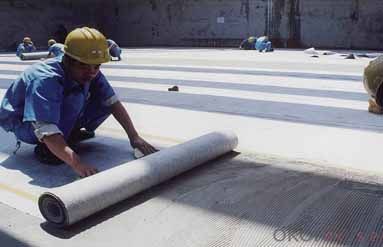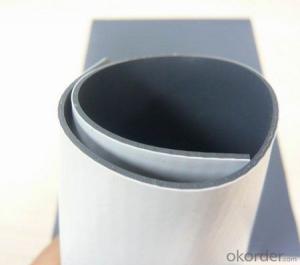PVC Membrane Smooth for Waterproof System
- Loading Port:
- Qingdao
- Payment Terms:
- TT or LC
- Min Order Qty:
- 10000 m²
- Supply Capability:
- 100000 m²/month
OKorder Service Pledge
OKorder Financial Service
You Might Also Like
PVC Membrane Smooth for Waterproof System
Description Of PVC Membrane Smooth for Waterproof System:
1. PVC Membrane Smooth is made from PVC and poliester , which is for waterproofing of exposed and non-exposed applications.
2. PVC Membrane Smooth adopts the world-advanced equipment of cold feeding extrusion and continuous vulcanization technology.
3. PVC Membrane Smooth is of high elasticity among high polymer waterproof materials and becomes a world-popular waterproofing material.
Main Features of PVC Membrane Smooth for Waterproof System:
1. Excellent physical and mechanical performance
2. High tearing resistance
3. Good deformation adaptability
4. High puncture resistance
5. High aging resistance
6. UV resistance
Specifications of PVC Membrane Smooth for Waterproof System:
Material | PVC |
Size | 1.2m (width)*20m (length) or customized, weldable type 2.05m |
Thick | 1.2mm, 1.5mm, |
Type | Smooth |
Pattern | Non-reinforced (homogeneous) |
Certificate | ISO9001/14001 |
Applications of PVC Membrane Smooth for Waterproof System:
1.Roofs, Basement, Toilets
2. Industrial and civil building waterproofing
3. Geosynthetic liner for swimming pool, channels, irrigation system
IMages of PVC Membrane Smooth for Waterproof System:



FAQ:
1. What are we supplying?
We are specialized in producing Colorful Asphalt Roof Shingle, SBS/APP modified bitumen waterproof membrane, Self adhesive bitumen waterproof membrane, PVC waterproofing membrane, EPDM rubber roofing membrane, Single Component Polyurethane Waterproof Coating, and Spray Polyurea Waterproof Coating
.
2. How Many years experience do we have?
We have been exported to more than 15 countries in the past 10 years.
3. How long do we usually reply your request?
We always reply our customer within 12 hours.
- Q:Can waterproofing membranes be used for planter boxes?
- Planter boxes can indeed benefit from the use of waterproofing membranes. These membranes are specifically designed to keep water from entering surfaces and can be applied to a variety of materials like wood, concrete, and metal. When a waterproofing membrane is applied to the inside of a planter box, it acts as a shield, safeguarding the material against water damage and extending the planter box's lifespan. This is especially advantageous for wooden planter boxes because it prevents the wood from decaying or deteriorating over time. Moreover, the waterproofing membrane also aids in retaining moisture within the planter box, preventing water leakage and ensuring that plants receive an adequate water supply for healthy growth. Ultimately, the use of waterproofing membranes for planter boxes enhances their durability and performance, making them a popular choice for both indoor and outdoor gardening.
- Q:Can waterproofing membranes be painted over?
- Yes, waterproofing membranes can be painted over. However, it is important to use a paint that is compatible with the membrane material and to ensure that the membrane is clean and dry before painting. Additionally, it is advisable to consult the manufacturer's guidelines or seek professional advice to ensure proper adhesion and longevity of the painted surface.
- Q:Can a waterproofing membrane be used on insulation surfaces?
- Indeed, one can apply a waterproofing membrane to insulation surfaces. In fact, it is often advised to incorporate a waterproofing membrane above insulation as an extra layer of defense against water infiltration. This is particularly crucial in areas where moisture poses a concern, such as basements, roofs, or exterior walls. The waterproofing membrane functions as a barricade, preventing water from permeating the insulation and causing harm. It also aids in preserving the insulation's integrity and effectiveness by keeping it dry. Furthermore, certain waterproofing membranes have the added advantage of enhancing the insulation's energy efficiency by reducing air leakage and heat transfer. All in all, utilizing a waterproofing membrane on insulation surfaces is an intelligent and practical solution to safeguard your building or home from water damage.
- Q:Is a waterproofing membrane breathable?
- No, a waterproofing membrane is generally not breathable as its primary purpose is to prevent water from passing through.
- Q:Are there any specific requirements for installing a waterproofing membrane?
- Yes, there are specific requirements for installing a waterproofing membrane. These requirements may vary depending on the type of membrane being used and the specific application. However, some general requirements include: 1. Surface Preparation: The surface where the membrane will be installed must be clean, dry, and free from any dust, debris, or contaminants. Any cracks or defects in the surface should be repaired prior to installation. 2. Adhesive or Bonding Agent: Depending on the type of membrane, an adhesive or bonding agent may be required to ensure proper adhesion to the substrate. This adhesive should be compatible with both the membrane and the substrate. 3. Primer: In some cases, a primer may be necessary to enhance the adhesion between the substrate and the membrane. The type of primer required will depend on the specific membrane and substrate being used. 4. Seam and Joint Preparation: Properly preparing seams and joints is crucial to ensure a watertight installation. This may involve using a specific sealant or tape to reinforce the seams and prevent water penetration. 5. Installation Techniques: The membrane should be installed according to the manufacturer's instructions and industry best practices. This may include using a specific method such as torching, hot air welding, or cold adhesive application. 6. Overlaps and Transitions: Properly overlapping the membrane sheets and ensuring smooth transitions between different areas is essential for a successful installation. This will help prevent water from seeping through gaps or weak points in the membrane. 7. Quality Control: Regular inspections and quality control measures should be implemented throughout the installation process to ensure that the membrane is being installed correctly and meets the required standards. It is important to consult the manufacturer's guidelines and specifications for the specific waterproofing membrane being used, as different membranes may have unique installation requirements. Additionally, local building codes and regulations should also be considered to ensure compliance and to meet any specific requirements in your area.
- Q:Can a waterproofing membrane be used for a foundation wall?
- Yes, a waterproofing membrane can be used for a foundation wall. Waterproofing membranes are commonly used to prevent water infiltration and moisture issues in below-grade structures such as basements and foundation walls. These membranes act as a barrier to protect the foundation from water damage, helping to keep the interior of the building dry and preventing structural problems caused by moisture.
- Q:Can a waterproofing membrane be used on both horizontal and vertical surfaces?
- Yes, a waterproofing membrane can be used on both horizontal and vertical surfaces. Waterproofing membranes are designed to create a barrier against water penetration, regardless of the surface orientation.
- Q:APP selection of asphalt waterproofing membrane selection points
- 3, Ⅱ type fiberglass fetal APP modified asphalt waterproofing membrane tension is higher, dimensional stability and heat resistance, good, but no elongation. Suitable for general and relatively cold areas and stable structure of the general engineering roof or underground waterproofing works.
- Q:Can a waterproofing membrane be used on precast glass surfaces?
- Indeed, precast glass surfaces can benefit from the utilization of a waterproofing membrane. It is common for precast glass surfaces to possess joints and seams that allow water to infiltrate. Applying a waterproofing membrane can effectively establish a protective barrier against water penetration. By doing so, the waterproofing membrane acts as a safeguard, preventing moisture from seeping into the joints and causing potential harm to the precast glass. It is crucial to select a waterproofing membrane specifically designed for glass surfaces and to adhere to the manufacturer's guidelines for proper application. Moreover, it is prudent to perform regular maintenance and inspections to ensure that the waterproofing membrane remains effective over time.
- Q:Is a waterproofing membrane necessary for all types of construction?
- Not all types of construction require a waterproofing membrane, but it is highly recommended for certain projects. The necessity of a waterproofing membrane depends on various factors, including the construction's location, purpose, materials used, and potential exposure to water or moisture. In areas where water intrusion is common, such as basements, foundation walls, roofs, bathrooms, and high humidity areas, a waterproofing membrane is crucial. These areas are prone to water damage, which can lead to structural problems, mold growth, and degradation of building materials. Waterproofing membranes create a reliable barrier against water penetration, preventing any damage from moisture. They are typically made from materials like asphalt, rubber, or polyethylene, and are applied as a thin layer to create a watertight seal. Some membranes also provide insulation benefits, improving the construction's energy efficiency. While a waterproofing membrane may increase construction costs, its advantages outweigh the expenses in the long term. It safeguards the building's structural integrity, extends its lifespan, and prevents costly repairs or renovations due to water damage. However, not all construction projects require a waterproofing membrane. For instance, buildings in arid regions or areas with little rainfall may not need extensive waterproofing measures. Likewise, certain construction types, like open-air structures or temporary installations, may not require a waterproofing membrane. Ultimately, the decision to include a waterproofing membrane in a construction project should be based on a thorough evaluation of the specific conditions, risks, and project requirements. Seeking guidance from a professional architect or engineer can help determine the necessity of a waterproofing membrane and the most suitable type for the construction.
1. Manufacturer Overview |
|
|---|---|
| Location | |
| Year Established | |
| Annual Output Value | |
| Main Markets | |
| Company Certifications | |
2. Manufacturer Certificates |
|
|---|---|
| a) Certification Name | |
| Range | |
| Reference | |
| Validity Period | |
3. Manufacturer Capability |
|
|---|---|
| a)Trade Capacity | |
| Nearest Port | |
| Export Percentage | |
| No.of Employees in Trade Department | |
| Language Spoken: | |
| b)Factory Information | |
| Factory Size: | |
| No. of Production Lines | |
| Contract Manufacturing | |
| Product Price Range | |
Send your message to us
PVC Membrane Smooth for Waterproof System
- Loading Port:
- Qingdao
- Payment Terms:
- TT or LC
- Min Order Qty:
- 10000 m²
- Supply Capability:
- 100000 m²/month
OKorder Service Pledge
OKorder Financial Service
Similar products
New products
Hot products
Related keywords






























